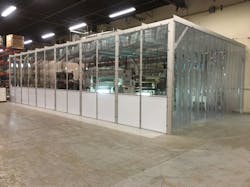LPS Industries looks to future with clean-room certification
By Karen Hanna
Food packaging doesn’t always have to be made in a clean room — a reality that has given one flexible packaging maker the opportunity to set itself apart.
“Depending upon what’s going into the pouch or bag determines whether or not it’s going to need a clean room,” said Paul Harencak, VP of LPS Industries LLC, a Moonachie, N.J., manufacturer that has been using a new clean room for zipper-locked food packaging. “Our belief is anybody putting food in a roll-stock or web-stock material should want a clean-room certification, but we don’t see that that’s enforced by the FDA across the board.”
In the fall, LPS celebrated its Safe Quality Food (SQF) certification by NSF, Ann Arbor, Mich. — the latest in a string of certifications it’s received since its clean room was installed in 2021.
Based just a dozen or so miles from New York City, LPS and its 150-or-so employees are no stranger to clean-room work — it retired a space dedicated to medical device manufacturing a few years ago. It uses supplier-produced films incorporating a variety of materials, including PET, PE, aluminum and other foils, and PP, to make flexible packaging for “every type of market you can think of ... from industrial to general use to a medical device to food,” Harencak said. End products include packing list envelopes, and resealable and gusseted bags and pouches.
The company has sales and warehousing distribution facilities in the Indianapolis, Los Angeles and Atlanta areas.
For a manufacturer familiar with food quality standards and prior clean-room experience, getting a new clean room meant building upon protocols already in place.
Planning began three years ago, Harencak said.
LPS’s quality-assurance manager took the lead in directing the project alongside Airborne Quality — chosen in part because of its proximity to the project.
LPS beefed up its protocols based on SQF standards.
Because of its new clean room, LPS has added an SQF coordinator and ramped up training for its employees, Harencak said.
“We trained those in good manufacturing practice for food-quality standards. We trained the new procedures that we needed to have for entering the clean room, exiting the clean room and the like. So, as we built the system, we trained along the way,” he said.
In its new clean-room space — measuring about 3,000 square feet within LPS’s 250,000-square-foot facility — LPS is running slitters from Ashe Converting Equipment, Ipswich, England; a laminator from Nordmeccanica NA Ltd., Hauppauge, N.Y.; and materials-handling equipment from a variety of OEMS; along with proprietary technologies.
“We have all that equipment,” Harencak said. “It was a matter of bringing it up to SQF standards, which was fairly easy to do.”
Harencak noted that he’s observed greater demand for food packaging, along with a trend toward flexible packaging over rigid packaging.
All that bodes well for the future of LPS’s new clean room.
“We have been certified,” he said. “We’re just waiting for the paperwork to come through, and our direct sales force and our sales representatives and distributors are out there now, saying, ‘Hey, we can give you the necessary certification. ... And all of our raw materials are FDA-compliant, as well. So, it really answers a lot of questions for those people looking to buy either flat seal bags or pouches or gusseted pouches.”
Karen Hanna, senior staff reporterContact:
Airborne Quality, Rahway, N.J. 732-382-8580, www.airbornequality.com
About the Author
Karen Hanna
Senior Staff Reporter
Senior Staff Reporter Karen Hanna covers injection molding, molds and tooling, processors, workforce and other topics, and writes features including In Other Words and Problem Solved for Plastics Machinery & Manufacturing, Plastics Recycling and The Journal of Blow Molding. She has more than 15 years of experience in daily and magazine journalism.

